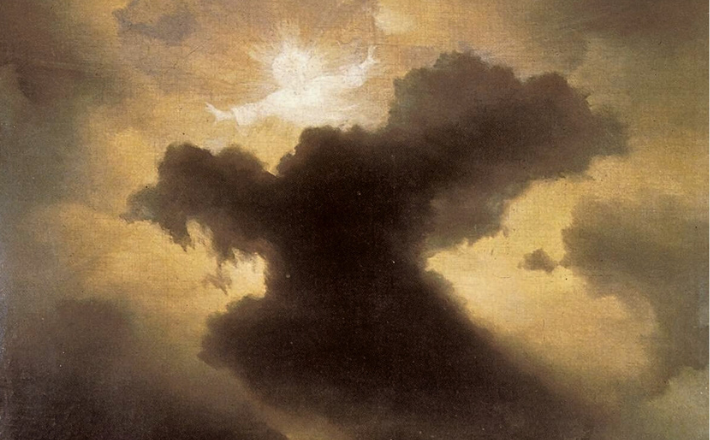Commentary on Genesis 1:1—2:4a
Genesis 1:1 begins the first of several creation stories in the Bible.
Commentators typically point out that Genesis 2:4b starts a second creation story—of Adam and Eve in Eden—with a different sequence of events, a different means by which God creates, and even different language naming “the Lord” God. But creation stories are not only at the beginning of the Bible.
Another famous creation story is at the start of John’s gospel. The personified “Word” (logos) is there at the beginning of creation, identified as God, with God; as integral to all creation; as life, as light, and as Jesus (John 1:1–18). John’s exaltation of “the Word” is similar to a creation story in Proverbs 8, in which personified “Wisdom” (hokhmah) is the first of God’s creations, and she was with God in the creation of the world (Proverbs 8:22–9:6).
The Hebrew Bible also contains glimpses of a more violent creative event absent from these other accounts. In a few places, biblical authors recall a primordial combat myth wherein God established order and security by vanquishing a threatening, chaotic sea monster (Job 26:5–14; Psalm 74:12–17; Isaiah 51:9). By contrast, Psalm 104 praises God for the wonders of a harmonious natural ecology where there is even a role for Leviathan, the infamous chaos monster, to play in the water (Psalm 104:25–26).
When I teach students that the Bible has several different creation stories instead of one biblical creation story, I try to dissuade readers’ impulse to put Genesis 1:1–2:4a into conversation (or conflict) with modern science or history. Instead, I encourage students to note that the biblical authors could have imagined—and did imagine—creation in multiple ways. Therefore, a crucial question is, What is special about this creation account for a particular context?
In its ancient context, the phenomenon of a seven-day creation is markedly distinct from other creation stories in the Bible and neighboring Mesopotamian and Egyptian sources. In complex ways, a sevenfold structure is built into Genesis 1:1–2:4a, even though the series of creative events could easily be told without any pattern of sevens. The passage includes more than seven utterances from God (God speaks 10 times: in 1:3, 6, 9, 11, 14–15, 20, 22, 24, 26, 28–30), and the third and sixth day each have two creative acts, which makes a total of eight creative acts from God. Thus, it is fascinating to see how biblical authors crafted this material to fit with a sevenfold pattern.
In a surreptitious way, there are numerous instances where key words occur in multiples of seven that can hardly be coincidental.1 But the more obvious feature is a timeline with a balanced relationship between two sets of three days, capped by a special seventh day. God brings about “realms” on days one (light and darkness in Day and Night), two (Sky and waters below), and three (Earth as distinct from Seas) that are sequentially populated on days four (by “lights in the dome of the sky to separate the day from the night” [verse 14]), five (birds and sea creatures), and six (land animals, including humans). Day seven is set apart as the culmination when God rests.
By presenting such a well-structured creation, ancient Israelite authors could give assurance that God establishes meticulous order for all the cosmos. In contexts across history, one can appreciate the ordering capacity of God as evidence that there is meaning to life, despite what Shakespeare calls “the slings and arrows of outrageous fortune” (Hamlet, Act 3, Scene 1).
More specific than this general reassurance of meaningfulness, the seven-day structure crowned with God resting speaks to the importance of the Sabbath in God’s well-designed world. Some scholars have argued that the seven-day creation story is modeled on an older Babylonian akitu festival spanning several days that would celebrate the new year (with, among other things, the reading of a creation story, Enuma Elish). A great innovation from the biblical authors is transforming “the annual renewal of the world [into] a weekly event.”2
With rest every Sabbath, we are invited to imitate God and participate in this renewal. Indeed, the Ten Commandments call for Sabbath observance with the reminder, “For in six days the Lord made the heavens and the earth, the sea, and all that is in them, but he rested on the seventh day. Therefore the Lord blessed the Sabbath day and made it holy” (Exodus 20:11).
In modern contexts, another meaningful detail from this creation story is the depiction of humans as “in the image of God” (Genesis 1:26–27). When God says “in our image and in our likeness,” believers often wonder why a plural pronoun is used. Although it is attractive for Christians to think of this as witnessing to a trinitarian God, in its ancient context, this verse references the belief that the supreme God heads a divine council populated by many divine beings (see, for example, Deuteronomy 32:8; Job 1:6; Psalm 82). For the ancient audience, the verse says that humans, male and female, are created in the image of the gods.
Physically speaking, this is not a profound insight in the ancient world since it was common to depict divine beings (at least partially) anthropomorphically. However, in another sense, it is a surprising democratization because the concept “image of God” was commonly used to set apart kings as supreme authorities like gods. Thus, through labeling all humanity as “in the image of God,” this creation story grants a major responsibility to the whole human race as God’s viceroy.
Modern contexts where the inclusive and egalitarian spirit of “the image of God” becomes most meaningful are when the phrase specifically affirms the value and rights of people who are degraded or disregarded and is coupled with action to improve their lives.
Notes
- Jon D. Levenson, Creation and the Persistence of Evil: The Jewish Drama of Divine Omnipotence (Princeton: Princeton University Press, 1988), 66–67.
- Levenson, 77.
PRAYER OF THE DAY
Grand designer of all things,
The light and darkness, the dome in the midst of waters, the sky and dry land, the vegetation, the seasons, the swarms of living creatures, birds and great sea monsters, creeping things and wild animals, and us; all these were brought into being with a word on your lips. And it was good. Amen.
HYMNS
Come, my way, my truth, my life ELW 513, H82
Creating God, your fingers trace ELW 684, H82 394, 395, NCH 462, UMH 109
CHORAL
With a voice of singing, Kenneth Jennings



September 7, 2025